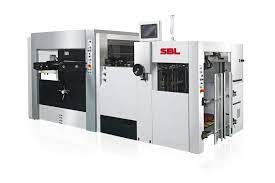“Shaping the Future: The Technological Evolution of Die-Cutting Machinery in Modern Manufacturing”
In the realm of manufacturing, precision and efficiency are paramount. Die-cutting machinery, a cornerstone in the production of intricate shapes and designs out of various materials, embodies these qualities. This article delves into the technological advancements that have propelled die-cutting machinery to the forefront of modern manufacturing processes, highlighting its pivotal role in industries ranging from packaging to electronics.
Die-cutting technology has come a long way from its manual and mechanical origins. Today’s die-cutting machines are marvels of precision engineering, incorporating the latest in digital controls, software integration, and automation. These advancements enable the production of components with unparalleled accuracy, speed, and consistency, which is crucial in today’s fast-paced market.
One of the most significant advancements in die-cutting machinery is the adoption of servo motors and computer numerical control (CNC) technology. This combination allows for the meticulous control of the die-cutting process, enabling the creation of products with intricate designs and tight tolerances. The digital control offered by CNC technology also facilitates quick setup times and easy adjustments, making it possible to switch between projects with minimal downtime.
Another technological leap is the integration of laser cutting technology with traditional die-cutting processes. Laser die-cutting machines offer a non-contact method of cutting, which is ideal for delicate or difficult-to-cut materials. This method not only expands the range of materials that can be processed but also enhances the precision and quality of the cut edges. Furthermore, laser cutting allows for complex patterns that would be challenging or impossible to achieve with conventional dies.
Automation and robotics have also made their mark on die-cutting machinery, transforming it into a highly efficient, autonomous production unit. Automated feeding systems, for example, ensure a continuous supply of material to the machine, while robotic arms handle the finished products, streamlining the entire manufacturing process. This automation not only boosts productivity but also reduces labor costs and the potential for human error.
The integration of software and digital technologies is another frontier. Modern die-cutting machines are often equipped with sophisticated software that enables designers to create detailed patterns and prototypes directly on their computers. This direct-to-machine capability significantly reduces the time from design to production, allowing for faster turnaround times and greater flexibility in product development.
Environmental sustainability has also become a key consideration in the design of die-cutting machinery. Manufacturers are now focusing on energy efficiency, reducing waste, and using environmentally friendly materials. These efforts not only help companies meet regulatory requirements and reduce operational costs but also appeal to the growing market of eco-conscious consumers.
In conclusion, die-cutting machinery has evolved into a cornerstone of modern manufacturing, thanks to significant technological advancements. From digital controls and laser cutting to automation and software integration, these machines offer unprecedented precision, efficiency, and flexibility. As manufacturers continue to innovate, we can expect die-cutting machinery to play an even more significant role in shaping the future of manufacturing, driving efficiency, and sustainability in an increasingly competitive market.



